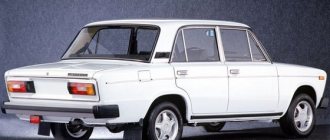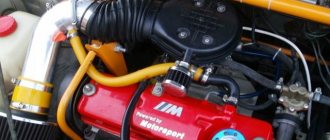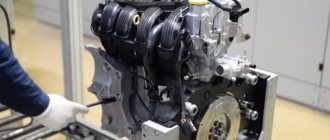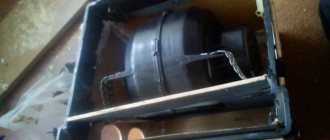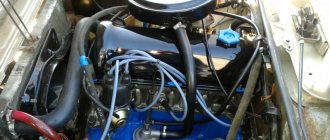VAZ-2106 is a true classic of the Soviet automotive industry. The car was produced for a long time after the collapse of the Union, which is explained by its incredible reliability. In addition, it stands out from other domestically produced cars due to its amazing maintainability of literally every component, availability of spare parts, and unlimited possibilities for modernization.
An important advantage of the VAZ-2106 is the engine used in this car. This four-stroke unit, equipped until 2002 with a carburetor and then with an injection fuel ignition system, can run on even the lowest quality gasoline, rarely fails in extreme cold, and can be operated successfully in almost any conditions. Any of its problems are eliminated even without the participation of a specialist - any more or less experienced car enthusiast can easily cope with routine repairs.
Weight and technical characteristics of the VAZ 2106 engine
The weight of the assembled VAZ 2106 engine is 121 kilograms. Together with the cylinder head and ignition system, the unit becomes heavier by another 19 kg, and if you add to this the gearbox with related devices, the total weight of the equipment will be 146 kg.
The technical characteristics of the engine at the time of production were advanced: engineers reworked the previous engine, increasing the cylinder diameter and increasing the power of the unit. The engine is a four-stroke, four-cylinder, in-line engine. The gasoline internal combustion engine with a capacity of 77 horsepower is equipped with a carburetor, but injection models were also produced that have slightly less power - only 75 hp. With.
Motor 2106 is the most powerful mass-produced small-displacement power unit produced in the USSR.
In 1984, Bulgarian engineers released a diesel version of the engine, but they failed to achieve an increase in power, although the weight of the VAZ 2106 engine increased by 10 kilograms.
Structural elements of the VAZ 2106 engine
Having found out how much the VAZ 2106 engine weighs, let’s look at the design features of the unit:
- Fuel is supplied to internal combustion engines equipped with carburetors by a mechanical diaphragm-type pump. From the carburetor, the air-fuel mixture enters the intake manifold, and from there into the combustion chambers. Exhaust gases are discharged as standard - through a muffler.
- The engine oil circuit is combined: depending on the type of unit, it is capable of supplying lubricant both by splashing and under pressure.
- The engine ignition system was initially a contact system - equipped with a voltage distributor with a breaker, but later it acquired a Hall sensor and an electronic switch.
- The timing mechanism is driven by a chain - after the failure with the belt drive, the development engineers returned to the traditional design.
- The engine cooling system is classic liquid, equipped with a thermostat. The refrigerant circulates through the channels, removing excess heat from the hot elements and transferring it to the stove in the cabin, as well as to the radiator for cooling.
Cooling circuit of the “six”.
The power unit, gearbox and clutch are mounted on three shock-absorbing supports, which not only take on the entire mass of the mechanisms, but also soften the loads that arise when the engine is running and the vehicle is moving.
What internal combustion engine models were still installed on the “six”
VAZ-21061 (LADA 1500 S) cars were equipped with a VAZ 2103 power unit with a volume of 1.45 liters. The cars were produced for export to the Netherlands, Canada and England, as well as for the country’s domestic market (in the latter case, they were sometimes equipped with a simplified cooling system - without an electric fan). The diameter of the engine cylinders is 3 mm smaller than that of the “native” version, so it has a different cylinder-piston group and the cylinder block itself.
The VAZ-21063 (LADA 1300 SL) model was equipped with VAZ-21011 engines. The installations had several design differences from 2106:
- smaller volume (only 1.3 l);
- The internal combustion engine was equipped with an oil pressure sensor;
- the piston stroke was 1.4 cm shorter, and accordingly the dimensions of the crankshaft, timing drive and cylinder block were also changed;
- Instead of an impeller with a drive belt, most engines were equipped with an electric fan.
Production of VAZ-21011 power units was discontinued in 1994.
Service
This section includes changing the oil and adjusting the valves (8 and 16 valve engines).
Experts recommend changing the oil every 15 thousand kilometers. If you do not comply with these requirements, the power unit will quickly fail. The fact is that oil loses its properties over time and accumulates many harmful substances. Without changing the oil and flushing the engine, the car will not last long. The VAZ 2110 engine mounts are also being replaced.
Procedure during draining:
- Unscrew the plug located under the bottom of the power unit. In this case, you can use a special key;
- Carefully drain the used oil so that it does not get on your skin. If you are not careful, you can get a very serious burn to the skin as the oil is very hot;
- Next, you can wipe the bottom of the power unit to get rid of any remaining oil;
- Screw the plug back;
- We unscrew the oil filter, which is located under the hood of the vehicle. To make your work easier, you can use a set of keys. We also replace the engine mount;
- Coat all filter gaskets with a thin layer of oil. This is necessary so that the filter can easily fit into the fitting place. The force applied should be monitored very carefully. If you exaggerate with force, you will strip the thread.
Actions during pouring:
- Carefully unscrew the filler cap;
- We take new oil in our hands and begin to pour it into the neck in the amount of three liters. In this case, you need to monitor the level so as not to overfill. Otherwise, the oil will end up in unnecessary areas of the engine;
- Next, you can start the power unit and wait a few minutes until the system warms up and the oil goes through several circles. Only after 20 minutes can you check the oil level. If it is not enough, then feel free to add more. In other cases, the process is completed, you can screw on the cover and put in the replaced engine mount;
- We also check the dashboard. The Check Engine light should not be on.
This process is the most complex and quite interesting. The performance of the power unit and its stability will depend on the correctness of the actions.
If you want to tune the VAZ 2110 engine, then adjusting the valves can be classified as some kind of tuning.
The adjustment is carried out using the device:
- Open the valve mechanism cover and completely remove the timing belt cover;
- We install a device that will allow you to easily carry out all the actions;
- We put the necessary marks on both the crankshaft and the camshaft. They are necessary for proper adjustment. You should also check the timing belt. It should be taut, not hanging;
- Checking the gap;
- Next, unscrew the washer and replace it with a new one according to the formula:
- where A is the measured gap;
- B – thickness of the removed washer;
- C – nominal gap;
- N – thickness of the new washer.
History of creation and advantages of the VAZ 2106
At the time of its creation and many years later, the “six” was an advanced car. The model based on the 2103 acquired not only an improved and more powerful motor, but also a new electrical circuit, as well as an improved external design. The car was capable of reaching a significant speed for those times - 150 km/h , while the acceleration time from zero to hundreds was only 16 seconds.
The design power of the internal combustion engine was 80 horsepower, but in practice the developers were unable to achieve this value, because the design of the original engine (VAZ 2103) was designed for a smaller volume of combustion chambers.
The salon has also changed in a positive way:
- a tachometer appeared on the instrument panel;
- sound insulation has been improved;
- the seats now have headrests and a textured surface;
- The interior has also become significantly more comfortable compared to the previous model, in which the main emphasis was on practicality.
The legendary VAZ 2106 Brezhnev.
The unique VAZ 2106 car with the popular name “Half six” was produced in 1997 on a special order for L. I. Brezhnev. The model had a slightly modified hood, and also installed seats and a radiator from the “Seven”, which at that moment was still at the development stage.
Maintenance Procedure
The classic design of the internal combustion engine allows you to get by with simple steps when servicing the engine:
| Maintenance object | Time or mileage (whichever comes first) |
| Timing belt | replacement after 100,000 km |
| Battery | 1 year/20000 |
| Valve clearance | 2 years/20000 |
| Crankcase ventilation | 2 years/20000 |
| Belts that drive attachments | 2 years/20000 |
| Fuel line and tank cap | 2 years/40000 |
| Engine oil | 1 year/10000 |
| Oil filter | 1 year/10000 |
| Air filter | 1 – 2 years/40000 |
| Fuel filter | 4 years/40000 |
| Heating/Cooling Fittings and Hoses | 2 years/40000 |
| Coolant | 2 years/40000 |
| Oxygen sensor | 100000 |
| Spark plug | 1 – 2 years/20000 |
| Exhaust manifold | 1 year |
As the actual life of the internal combustion engine increases, consumables may be replaced more frequently than specified, or operations for cleaning the carburetor, engine, jets, and other attachments may be added.
Motor maintenance
How much does the VAZ-2101 weigh? Weight of the VAZ-2101 body and engine
How much the VAZ-2101 weighs is affected by the wear of metal parts, the presence of additional body kit and gas equipment. It is worth noting that the vast majority of modern sedans are equipped with a monocoque body configuration. “Kopeyka” in this case is no exception. This design is a steel box, inside of which there is a compartment for passengers, driver and luggage. In addition, the body carries the working components and assemblies of the vehicle.
Design features
Regardless of how much the VAZ-2101 weighs, the car body experiences not only static stress from the equipment installed on it, but is also forced to resist its effects under dynamic load. This property of the box is called torsional rigidity. On the car in question, this figure is approximately 7300 Nm/deg.
This technical parameter is significantly influenced by the condition of the bottom, roof, and thresholds. This is due to the fact that these elements are interconnected by the front panel. In addition, the strength characteristics and geometry of the body depend on the integrity of the door pillars, window panels and luggage compartment cross member. You can check the correct symmetry and general condition of the machine yourself. To do this, take the actual dimensions of the frame and compare them with the parameters specified in the car repair manual.
Load distribution
From the above it follows that the fatigue of the VAZ-2101 body directly affects the state of the control points for fixing units and components, and is also manifested in the correct geometry of its front, rear and side openings.
When moving (in dynamics), the distribution of loads on the frame occurs as follows:
- From the front suspension parts, vibration and mechanical moments are transformed to the cross member with subsequent transfer to the sub-engine frame part.
- Next, the force is transferred to the surface of the mudguards and the front shield, which are classified as load-bearing body elements.
- In the rear, a similar picture occurs in a more simplified form. There are no motor mounts involved here; the transition goes straight from the suspension to the car frame.
Total information
| Options | VAZ 2107 | VAZ 21074 | VAZ 2107-20 | VAZ 21074-20 |
| Weight of the equipped vehicle, kg | 1060 | 1060 | 1060 | 1060 |
| Payload, kg | 400 | 400 | 400 | 400 |
| Permitted maximum weight, kg | 1460 | 1460 | 1460 | 1460 |
| Ground clearance of a vehicle with a permissible maximum weight, with tires 175/70 R13, not less, mm: | ||||
| to the front suspension cross member | 162 | 162 | 162 | 159 |
| to the rear axle beam | 157 | 157 | 157 | 154 |
| Permissible weight of cargo on the additional (top) luggage rack, kg | 50 | 50 | 50 | 50 |
| Maximum speed, km/h: | ||||
| with permissible maximum weight | 148 | 148 | — | — |
| with driver and passenger | 150 | 150 | 150 | 150 |
| Acceleration time from standstill to 100 km/h, s: | ||||
| with driver and one passenger | 17 | 16 | 17 | 16 |
| with permissible maximum weight | 19 | 17,5 | — | — |
| Minimum turning radius along the track of the outer front wheel, m | 5,6 | 5,6 | 5,6 | 5,6 |
| The greatest rise overcome by a car with a permissible maximum weight without acceleration in first gear, % | 36 | 36 | 36 | 36 |
Material of manufacture
With this configuration of the body and suspension, the frame material plays a significant role in the safety and stability of the car. It is logical that strengthening the weak points of the body will make the vehicle stiffer and more stable on the road. But then the mass of the car will be critical, which will make it clumsy and very heavy.
When strengthening the frame, the weight of the “penny” and the load on all structural elements increases. That is why design engineers are trying to select the rational thickness of materials, taking into account the ratio of their dimensions and cross-section. The result is a fairly durable and not too heavy body.
To reduce weight and save on costs, elements that do not bear the load are made of thinner metal. The main parts have a thickness of about one millimeter, which corresponds to similar indicators for other cars of similar class.
Tire weight, table
Low-profile tires To understand the relationship between wheel dimensions and weight, drivers should refer to specially compiled tabular materials that show all the basic tire parameters that affect this indicator and, accordingly, the average wheel weight for each size.
Tire weights, a table with the most popular parameters such as tire sizes, weight and volume, is presented below.
You may be interested in this About tires for special equipment
| Tire width, mm | Tire profile height, mm | Tire diameter, inches | Range of tire volumes for the given parameters, m³ | Weight range for the given wheel parameters, kg |
| 145 | 65 | 13 | 0,038–0,042 | 5,1–5,3 |
| 165 | 70 | 13 | 0,049–0,051 | 6,1–6,3 |
| 185 | 70 | 13 | 0,059–0,061 | 7,5–7,7 |
| 195 | 60 | 13 | 0,06–0,062 | 7,9–8,1 |
| 215 | 50 | 13 | 0.079–0,081 | 9,6–9,8 |
| 155 | 65 | 14 | 0,049–0,051 | 5,6–5,8 |
| 175 | 60 | 14 | 0,059–0,061 | 6,5–6,7 |
| 185 | 55 | 14 | 0,06–0,062 | 6,9–7,1 |
| 195 | 60 | 14 | 0,069–0,071 | 8,3–8,5 |
| 205 | 70 | 14 | 0,079–0,081 | 10,1–10,3 |
| 215 | 65 | 14 | 0,089–0,091 | 10,4–10,6 |
| 225 | 70 | 14 | 0,98–1 | 12,7–12,9 |
| 165 | 65 | 15 | 0,059–0,061 | 6,9–7,1 |
| 175 | 65 | 15 | 0,06–0,062 | 7,2–7,4 |
| 185 | 60 | 15 | 0,069–0,071 | 8,2–8,4 |
| 195 | 55 | 15 | 0,07–0,072 | 8,8–9 |
| 205 | 65 | 15 | 0,088–0,09 | 9,5–9,7 |
| 215 | 60 | 15 | 0,089–0,091 | 11,3–11,5 |
| 225 | 60 | 15 | 0,099–0,1 | 10,8–11 |
| 235 | 70 | 15 | 0,119–0,121 | 14,9–15,1 |
| 255 | 65 | 15 | 0,129–0,131 | 17,8–18,2 |
| 175 | 60 | 16 | 0,069–0,071 | 7,5–7,7 |
| 185 | 60 | 16 | 0,07–0,072 | 9,1–9,4 |
| 195 | 55 | 16 | 0,079–0,081 | 8,6–9,2 |
| 205 | 55 | 16 | 0,081–0,083 | 9,1–9,4 |
| 215 | 55 | 16 | 0,089–0,092 | 9,8–10,3 |
| 225 | 50 | 16 | 0,09–0,094 | 10,6–11 |
| 235 | 50 | 16 | 0,1–0,104 | 10,9–11,3 |
| 245 | 45 | 16 | 0,102–0,106 | 11,4–11,8 |
| 255 | 40 | 16 | 0,111–0,115 | 16,2–16,6 |
| 265 | 40 | 16 | 0,136–0,14 | 18,4–18,8 |
| 195 | 40 | 17 | 0,071–0,074 | 8,4–8,7 |
| 195 | 45 | 17 | 0,073–0,077 | 9–9,3 |
| 205 | 55 | 17 | 0,088–0,091 | 10,5–10,9 |
| 215 | 65 | 17 | 0,11–0,114 | 13–13,4 |
| 225 | 60 | 17 | 0,112–0,116 | 13,5–13,9 |
| 235 | 60 | 17 | 0,119–0,123 | 12,8–13,2 |
| 245 | 55 | 17 | 0,121–0,125 | 12,9–13,3 |
| 255 | 55 | 17 | 0,122–0,128 | 13,1–13,4 |
| 265 | 50 | 17 | 0,124–0,13 | 13,2–13,6 |
| 275 | 50 | 17 | 0,14–0,141 | 18,4 — 19 |
| 205 | 40 | 18 | 0,079–0,081 | 8,9–9,2 |
| 215 | 55 | 18 | 0,099–0,102 | 11,4–11,8 |
| 225 | 55 | 18 | 0,108–0,112 | 12,4–12,8 |
| 235 | 60 | 18 | 0,129–0,133 | 16,1–16,6 |
| 245 | 60 | 18 | 0,148–0,154 | 16,7–17,2 |
| 255 | 60 | 18 | 0,151–0,157 | 16,8–17,4 |
| 265 | 60 | 18 | 0,158–0,164 | 17–17,6 |
| 275 | 65 | 18 | 0,198–0,204 | 18,7–19,4 |
| 285 | 65 | 18 | 0,208–0,218 | 19,9–20,7 |
Important!
According to the given weights and tire volumes in the table, car enthusiasts only need to select the tire parameter they are interested in for their vehicle, and then multiply the corresponding weight of one tire by 4. This way, you can find out the weight of all the tires that need to be installed on the vehicle.
You may be interested in this About mud tires on UAZ
Wheel assembly
How much does the VAZ-2101 weigh?
The tail of the “penny” at the front and rear is welded to the frame of the vehicle, which makes it possible to include it in the supporting circuit. This also helps reduce the weight of the car. Below is a breakdown of the main parts of the first model Zhiguli (in kilograms):
- engine with associated equipment – 140;
- gearbox – 26;
- cardan shaft – 10;
- rear axle – 52;
- radiator – 7.0;
- body part - 280.
The total weight of the VAZ-2101 is 955 kilograms. It would seem that the figure is not very impressive. But if you multiply the balances by all the units, of which 4.85 million were produced, it becomes clear that every gram saved plays a significant role.
Additional processing measures
It is worth noting that with dimensions of 4.07/1.61/1.44 meters, the car in question has a fairly acceptable weight. The strength and integrity of the body is affected not only by how much a “penny” weighs and how thick the metal is, but also by the quality of factory and independent anti-corrosion treatment.
According to the rules, after welding procedures, before painting, the car body must undergo phosphatization. During this treatment, the entire surface of the frame was covered with a special phosphate film that is resistant to chemical attack. In addition, the effect was secured by applying a layer of primer, which was sprayed using electrophoresis. This allowed the primer to provide even coverage in the most difficult to reach areas. The bottom of the vehicle was treated with a special reinforced mastic, which reliably protects the bottom from the effects of an aggressive environment.
Interesting Facts
Classic VAZ cars have retained their original configuration and the love of the people until modern times, regardless of age and social status. The engineers of the Volzhsky Automobile Plant do not even think of stopping at the achieved result, developing and manufacturing new modifications.
It is noteworthy that of all Soviet passenger cars, only the “kopek” was delivered to the Land of the Rising Sun. The popularity of the models in question is largely due to Kimi Raikkonen, who achieved his first successes and victories on this particular car. The father of the legendary racing driver considered this car one of the most reliable representatives of its segment.
If you find out how much the VAZ-2101 and its followers weigh, you can note that over its half-century history this figure for the brand in question varied from 0.95 to 1.3 tons. There were no significant and cardinal changes in this direction.
In conclusion
“Kopeyka” is rightfully called a legend of Soviet automobile production. People appreciated this car for its reliability, practicality and affordability. This modification has not been produced for a long time, but it can be purchased on the secondary market. There are quite well preserved copies. In addition, the VAZ-2101 represents a limitless field for tuning. Craftsmen “put their hand” to literally all parts of the car, from equipping the interior to modifying the body and power unit.
How much does a Zhiguli engine weigh?
VAZ car engine weight:
| Model | Working volume, cm 3 | Power, hp | Weight, kg |
| VAZ 11183-1000260 | 1596 | 82 | 112 |
| VAZ 11194-1000260 | 1390 | 89 | 112 |
| VAZ 2103-1000260 | 1450 | 71,4 | 120,7 |
| VAZ 2104-1000260 | 1450 | 68 | 120 |
| VAZ 2106-1000260 | 1570 | 74,5 | 121 |
| VAZ 21083-1000260-53 | 1500 | 69 | 127,3 |
| VAZ 2111-100026080 | 1490 | 77 | 127,3 |
| VAZ 21114-100026080 | 1596 | 81,6 | 112 |
| VAZ 21124-100026080 | 1599 | 89,1 | 121 |
| VAZ 21126-100026080 | 1597 | 98 | 115 |
| VAZ 21128-100026080 | 1796 | 105 | 117 |
| VAZ 21213-1000260 | 1690 | 78,9 | 117 |
| VAZ 21214-1000260 | 1690 | 81 | 122 |
| VAZ 2123-1000260 | 1690 | 81 | 127 |
| VAZ 2130-1000260 | 1790 | 81,8 | 122 |
Random entries - how much does it weigh:
Permission is granted to reprint and distribute materials from this site with a direct indexed link.
For the rear-wheel drive sedan VAZ-2103 (LADA 1500) or simply “troika”, the domestic manufacturer initially provided a new engine 2103 with a displacement of 1.5 liters, built on the basis of 2101. This model also used proven engines from a “kopeck” to 1 .2 liters and from VAZ-21011 by 1.3 liters. VAZ 2106 engines were produced in small quantities for the third Zhiguli model.
Engine VAZ 2103
The 1.5-liter four-cylinder in-line carburetor power unit of the VAZ 2103 received an overhead camshaft, a timing chain drive and a high engine block, which allows the installation of a crankshaft with an extended piston stroke.
Zhiguli engines often suffer from camshaft wear or the lack of a tensioner in the drive chain, which needs to be tightened every 10 thousand kilometers. If a loud knocking noise occurs in the engine, you will have to adjust the valve clearances to avoid a drop in power, increased fuel consumption, valve burnout, and other things.
Also among the disadvantages of the engine for the “troika” is the need for constant adjustment and cleaning of CO. If the engine overheats, pay attention to the pump.
If tripping occurs, you need to change the compression.
Engine tuning is possible in a wide range: from boring to compressor and turbines.
Among motorists, the VAZ-2103 engine is in good standing, compared to other units in the line. The long service life is due to the availability of spare parts and their low cost. With careful treatment of the engine and timely maintenance, the VAZ-2103 will travel not 125 thousand kilometers declared by the manufacturer, but all 180-200 thousand kilometers.
Engine VAZ 2106
The 1.6-liter VAZ 2106 engine became a continuation of the VAZ 2103 and, as a consequence, 2101. The main differences from its counterparts are in the piston with a diameter increased to 79 mm, while the engine block remained unchanged.
There is also an injection unit 21067, which differs in its covered cylinder head from the Niva-21214 injection engine. Practice has shown that the “six” carburetor is more stable than the injector.
In general, the VAZ 2106 in-line engine has 4 cylinders, an overhead camshaft and a chain drive. Despite the possible service life of up to 180-200 thousand kilometers, among motorists the VAZ-2106 is considered less reliable than the “three ruble”. For the smooth functioning of the six engine in winter, it has to be heated for at least five minutes at 1500-2000 rpm.
The disadvantages of the VAZ-2106 include increased requirements for oil, which can affect the increase in cylinder diameter. It often happens that oil consumption is a liter or more per thousand kilometers, which requires replacing rings, valves, or other things.
Also among the disadvantages of the “six” are increased wear on the camshaft, engine detonation, and engine knocking due to defects in the piston pins or connecting rod bearings. If the carburetor engine operates unstable, pay attention to the jets. An engine that stalls at idle requires adjusting the air damper.
When the engine heats up or boils, you need to check the thermostat, radiator and the presence of air in the cooler.
Trouble in the 2106 engine is caused by incorrectly adjusted valves, valve burnout, worn-out cylinder head gasket and low-octane gasoline.
Modifications
The standard VAZ 2110 contains new developments and some features.
The first car was completely carburetor and 8 valve. This system had a volume of 1.5 liters and made it possible to develop about 70 horsepower.
This potential was enough to get real pleasure from movement. As for the maximum speed, it varies within 160 kilometers per hour.
After the carburetor engine, the designers decided to make an injector (already 16 valve). Essentially, these are the same 1.5 liters of volume, but with slightly increased engine power to 79 horsepower. This move made it possible to improve dynamism and increase maximum speed.
A small feature is that the system has a 16 valve VAZ engine. This is very unusual for cars of this class.
Until the 90s, the vehicle had a rather sparse interior and exterior. The designers made the car as a means of transportation, not a luxury. Only after the 90s were customers able to get a spacious trunk, comfortable seats, an adjustable steering wheel, air conditioning, and so on. Over the entire production period of the VAZ 2110, a huge number of modifications of its engine were developed: both an 8-valve carburetor and a 16-valve injector.
VAZ-2106 engine weight
On a VAZ-2106 car, the weight of the engine without gearbox is 121 kilograms. Therefore, it is strictly not recommended to try to remove or move this unit alone - this is a direct path to serious injury. It is best to hire an assistant who can help you during the process of dismantling or installing the motor.
With all the necessary equipment, including both the cylinder head and the ignition system, the engine weight will be even greater - 140 kilograms.
Finally, when assembled with the gearbox and the devices attached to it, this value will increase by another 26 kilograms.
As you can see, weight can be considered a significant disadvantage of the car compared to imported analogues. To reduce it, increase power, and also improve dynamic characteristics, many drivers today install parts made of light metal alloys.
In 1984, a diesel version of the “six” was released at a Bulgarian automobile company. Replacing a gasoline engine with a diesel engine didn't have much of an impact on the car's performance. Firstly, the Bulgarians failed to increase the power of the power unit. Secondly, its weight increased by about 10 kilograms, which can also be called a disadvantage of the alteration.
Where is the engine number located?
An important identifying characteristic of any motor is its number. On a VAZ 2106, the number is stamped in two places at once (for the convenience of the driver and supervisory authorities):
- On the left side of the cylinder block.
- On a metal plate under the hood.
Each number is stamped as clearly as possible, since an ambiguous interpretation of the number cannot be allowed
The engine number is assigned at the factory; corrections and interruptions of numbers in the number are not allowed.
Other characteristics of the VAZ-2106 engine
The weight of the motor is, although important, but far from its main characteristic. That is why we decided to talk about other features of the power unit installed on various modifications of the “six”. For example, engine power on carburetor models was 77 horsepower. After switching to an injector, it dropped to 75 hp. With. However, this parameter can always be increased by carrying out a number of upgrades.
The cylinder diameter of the VAZ-2106 power unit is 79 millimeters, the torque can reach 3000 rpm, and the working volume is 1568 cubic centimeters. Finally, the compression ratio of the engine is 8.5 atmospheres, and the piston stroke is 80 millimeters.
Tuning
And in conclusion, I would like to say about tuning the VAZ 2110 engine.
In the VAZ 2110, engine tuning is very easy to do. To do this, you only need a tool and a room. This process can be done not only in a specialized workshop, but also in your garage.
Tuning a VAZ 2110 engine requires only a set of tools and patience:
- The first step is to simply replace the camshaft with a better one. Due to this, power will increase and engine performance will improve.
- You can also install a new crankshaft to increase the volume of the unit. If this is not done, then further tuning of the VAZ 2110 engine will be in vain.
- The installation of a compressor is quite simple. This unit allows you to increase power and get good torque.
- It is worth noting that tuning the VAZ 2110 engine can be done by anyone. This does not require special experience or skills. It is enough to know the structure of the car and have locksmith skills. Experts recommend installing a high-quality stock piston so that it can withstand about 0.5 bar.
Weaknesses of the VAZ-2106 engine
The engine of the VAZ-2106 car is a modification of the power unit from the Troika. It is quite possible that this is why its design retained a number of weak points of its predecessors. Domestic craftsmen have learned to diagnose engine problems almost by sound. As an example, we will give several symptoms of breakdowns, and also tell you which engine elements could fail:
- The appearance of loud knocking noises at idle clearly indicates the need to adjust the valves. Under normal operating conditions, this problem usually occurs no more often than once every 7-10 thousand kilometers;
- The occurrence of metal-on-metal knocking indicates that the connecting rod bearings or piston pins are worn out. Both faults must be corrected immediately to prevent serious damage to the power unit;
- the so-called ceramic knock may indicate that the pistons of the VAZ-2106 have failed. You can still get to a car service center with such a breakdown, but it’s definitely not recommended to travel around the city and beyond;
- extraneous sounds in the lower part of the engine, which are accompanied by a sharp drop in the oil level - this is a clear sign of problems with the main bearings. In this situation, it is better to immediately use the services of a tow truck, since an independent trip even a short distance is fraught with major troubles.
In addition, quite often VAZ-2106 owners encounter the following carburetor and ignition system malfunctions:
- insufficient or, on the contrary, excessive fuel enrichment;
- throttle problems;
- failure of a high-voltage wire;
- moisture entering the ignition coil insulator;
- spark plug wear.
All these malfunctions, with experience, can be eliminated in no time - you just need to remove the damaged unit, disassemble it and, accordingly, replace the worn parts.
Engine optimization options
Many drivers tune the VAZ 2107 engine in order to improve performance and increase power. An important factor that affects power performance is clean injectors. Their contamination reduces engine performance, impairs efficiency, reduces the injected volume of fuel, which will lead to failures when pressing the gas pedal.
Usually the problem occurs due to the use of low-quality gasoline. Such fuel will contain heavy paraffins that build up on valve plates, injectors and the throttle valve. There are several options for cleaning them.
The first is cleaning and bench testing.
The permissible imbalance should be within 1.5%. If the deviation is more than:
- 2.5% - fuel consumption increases;
- 3.5% - unstable operation at idle, difficult cold start;
- 4% - dips occur during sudden acceleration;
- 5% - the engine does not start well, a persistent tripping appears.
The second option is to use special flushing fluid and equipment. Cleaning can be done at home. To do this, you need to dilute the flushing fluid with gasoline and add it to the power system. As a result, the deposits are corroded and enter the cylinder, where they are completely burned.
The quality of the oil used has a great influence on keeping the car in working condition.
How much does the VAZ weigh?
Perhaps one of the most popular cars in the post-Soviet space was, is and remains the VAZ. This car has captivated many generations. However, how did it all begin? When was the first VAZ car produced and how much did it weigh? You will learn the answers to these and other questions from this article.
The first VAZ car was produced by the Volzhsky Automobile Plant on April 19, 1970. The make of this car was VAZ-2101 Zhiguli. Its production was carried out according to the analogue of the Fiat concern. Moreover, VAZ owes its appearance to this particular brand of Fiat 124, produced in 1966. Here, in fact, is it:
As a result of some design improvements, the first domestic car, the VAZ 2101 of 1970, was produced:
The weight of this car was 955 kg. Moreover, of this mass the engine weighed 114 kg.
It has not lost its popularity to this day. In 2000, it was recognized as the best car among eighty thousand car enthusiasts surveyed in the CIS countries and Russia. It was named the best car of the century, VAZ 2101. At the time of its production, it was considered the most comfortable, reliable and modern domestic car. Its presence was a sign of wealth and prosperity!
In what models was the VAZ used?
Improved engine characteristics made it possible to equip VAZ cars of the following models with it:
- 2103 Zhiguli sedan;
- 21054 Zhiguli sedan (only for the FSB, the Ministry of Internal Affairs and the State Traffic Safety Inspectorate);
- 2106 Lada sedan;
- 21074 Lada sedan;
- 2121 Niva carrying a 5-door station wagon or 3-door hatchback.
VAZ 21054 for special services
Due to the following difficulties in manufacturing some parts, management considered the 2106 motor to be economically unprofitable and it was discontinued.
VAZ for scrap metal
- Scrap removal Scrap metal pickup
- Non-ferrous metal scrap
- Paper
VAZ for scrap metal
The First Scrap Metal Company is no longer alone in accepting old cars. By concluding a deal with us, you will not have to tediously wait for your funds. We work around the clock and are ready to accept your order immediately.
Please note: scrapping a car is not only a profitable decision, but also the right one from the point of view of protecting the environment.
How we are working
To begin with, the car is sent to a plant that processes metals. This is where they begin to separate old batteries, rubber and wiring from the car. After this, the parts are sent to the dismantling workshop. If there is any remaining gasoline in your car, it must be poured into a canister designed for this purpose. A completely disassembled car is just a pile of metal that will be sent to metal crushing equipment.
Everything that remains of the car is melted down. Recyclable materials will be simply an excellent source for making bodies for new cars. If you decide to sell your VAZ 2106 for scrap metal, you can:
- earn;
- clear the area around you of debris;
- contribute to improving the environmental situation;
- help in obtaining recyclable materials.
Documents needed to scrap a car:
- you must have a civil passport with you;
- passport of the car that is about to be scrapped;
- document authorizing disposal from the traffic police.
If you cannot deliver the car to the collection point yourself, then we will do it for you using special equipment for its delivery. We have a fleet of special vehicles for this!
The most frequently asked question is how much does a VAZ cost for scrap metal?
— We answer:
| VAZ model | Car weight | Blockage | Metal weight |
| 2101 | 955 kg | 30% | 668 kg |
| 2105 | 955 kg | 30% | 668 kg |
| 2106 | 1045 kg | 30% | 731 kg |
| 2107 | 1060 kg | 30% | 742 kg |
| 2109 | 945 kg | 30% | 661 kg |
| 21099 | 950 kg | 30% | 665 kg |
All data given in the table are approximate. For more information, please contact our manager.
Prices at the First Scrap Metal Company will be the most favorable for customers. Our company is official and takes great responsibility in determining the cost, which consists of the following factors:
- how much does the car weigh;
- what is the quality of its metal;
- Are the machine parts available?
- the shape of the machine itself.
The presence of an engine greatly increases the value of a car, because it contains a significant percentage of steel. Cast iron and steel are present in significant quantities in the chassis of the car. Nickel and copper are found in car electronics. In this regard, we can say that a more complete set of your car will bring more money upon delivery.
Why is it profitable to cooperate with us?
It is our company that will pay a high price for your scrap metal! We will come to you at exactly the agreed time, because we value our time and the time of our clients. The First Scrap Metal Company is distinguished by its integrity and works seven days a week and on holidays. Our specialists are highly qualified and experienced in similar work. Contact us to sell your VAZ 2107 for scrap! We will prepare the necessary accompanying documentation and pay instantly on the spot.
